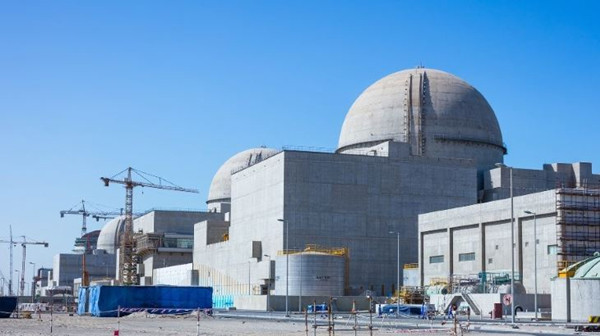New power reactors must be brought online over the coming decades to maintain nuclear's "key role" in combating climate change, according to newly published International Atomic Energy Agency (IAEA) projections.

The four units at the UAE's Barakah plant will be brought online by the end of 2020 (Image: ENEC)
Energy, Electricity and Nuclear Power Estimates for the period up to 2050 is the 38th edition of the IAEA's annual publication, based on actual statistical data from the agency's Power Reactor Information System and the United Nations Department of Economic and Social Affairs.
The country-by-country projections it contains are based on national projections supplied by countries to the OECD Nuclear Energy Agency and projections made by other international organisations, taking into account possible licence renewals, planned shutdowns and foreseeable construction projects. These are used to produce two scenarios: a low case, described as "conservative but plausible", which assumes that current market, technology and resource trends continue with few policy changes to affect nuclear power; and a high case, which assumes that current rates of economic and electricity demand growth continue.
The IAEA noted that at the end of 2017 there were 448 operational nuclear power reactors around the world, with a combined generating capacity of 392 GWe. These reactors produced a total of 2503 TWh of electricity last year, accounting for about 10% of total electricity production.
"Over the short term, the low price of natural gas and the impact of subsidised intermittent renewable energy sources on electricity prices are expected to continue to affect nuclear growth prospects in some regions of the world," the report says. "In the near term, ongoing financial uncertainty and declining electricity consumption in some regions will continue to present challenges for capital-intensive projects such as nuclear power."
Nuclear generating capacity is projected to reach 511 GWe by 2030 and 748 GWe by 2050 in the IAEA's high growth projection. This represents a 30% increase over current levels by 2030 and a 90% increase of capacity by 2050. The low case projects a 2030 nuclear capacity of 352 GWe, rising slightly to 356 GWe in 2050.
"There are increasing uncertainties in these projections owing to the considerable number of reactors scheduled to be retired in some regions around 2030 and beyond," the IAEA said. "Significant new capacity would be necessary to offset any retirements resulting from factors such as ageing fleets and economic difficulties."
In its low case, the IAEA projects that some 139 GWe of nuclear generating capacity will be retired by 2030, while 99 GWe of new capacity will be added. Between 2030 and 2050, a further 186 GWe will be retired and 190 GWe added. In the high case, which assumes several older reactors will be given licence extensions, only 55 GWe of capacity will be retired by 2030, with a further 207 GWe retired by 2050. In this case, 175 GWe of new nuclear capacity is added by 2030 and about 443 GWe added by 2050.
Total nuclear electricity production will continue to increase between now and 2050, according to the IAEA. In the high case, nuclear electricity production will increase to 3969 TWh in 2030 and 6028 TWh in 2050. In the low case, nuclear electricity production will increase to 2732 TWH in 2030 and 2869 TWh in 2050. The share of nuclear electricity in total electricity production will decrease in the low case from about 10.3% in 2017 to 7.9% in 2030 and 5.6% in 2050. In the high case, its share will increase to 11.5% in 2030 and to 11.7% in 2050.
The IAEA said interest in nuclear power "remains strong in the developing world", particularly in Asia. It suggests that commitments agreed to at the 21st session of the UN Climate Change Conference (COP21) "could also produce a positive impact on nuclear energy development in the future".
In a statement to the IAEA board of governors on 10 September, IAEA Director General Yukiya Amano said: "The Agency's latest annual projections show that nuclear power will continue to play a key role in the world's low-carbon energy mix. However, the declining trend in our low projection for installed capacity up to 2050 suggests that, without significant progress on using the full potential of nuclear power, it will be difficult for the world to secure sufficient energy to achieve sustainable development and to mitigate climate change."
The nuclear industry has set the Harmony goal for nuclear energy to provide 25% of global electricity by 2050. This will require trebling nuclear generation from its present level. Some 1000 GWe of new nuclear generating capacity will need to be constructed by then to achieve that goal. World Nuclear Association has identified three areas for action to achieve this: establishing a level playing field in electricity markets, building harmonised regulatory processes, and an effective safety paradigm.